The concept of an electrostatic sprayer is simple: charge cleaning particles so that they completely cover objects you’re trying to disinfect. The Ryobi cordless electrostatic sprayer accomplished this on an 18V battery platform. That gives you more freedom of movement so you’re not tethered to an outlet. We got in both the Ryobi PSP02K 1-liter handheld model as well as the Ryobi P2870 1-gallon backpack electrostatic sprayer to see how well they’d perform in the nursery of a local church.
Electrostatic vs Traditional Spraying
Each member of the Ryobi 18V Cordless Electrostatic Sprayer line uses battery power to positively charge your cleaner and disinfectant particles. Why do you need positively charged particles, you might ask?
Because your charged-up cleaner particles cling to all surfaces, they provide better coverage than traditional sprayers. Those only reach the areas the initial spray falls on.
The electrostatic spraying charges the particles. This creates a good kind of “static cling”. It causes the particles to adhere better and more completely to the surfaces you spray.
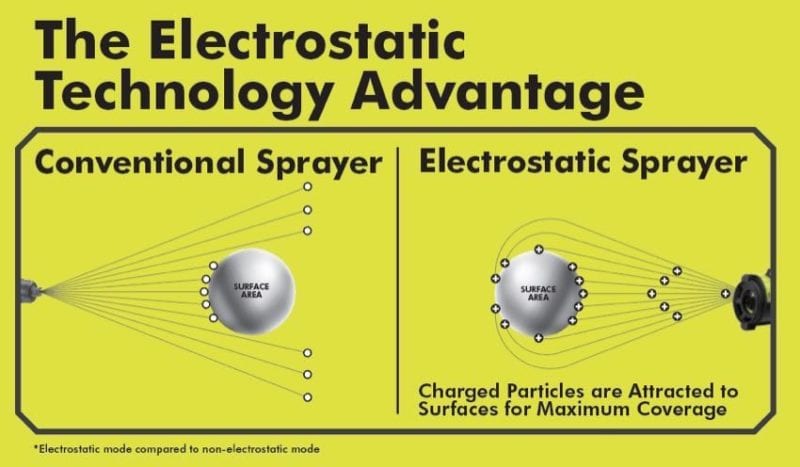
As seen in the above image, your traditional sprayer fires off cleaning solutions in a wide cone. You’ll hit what you mean to, but you’ll also spray down things around it, and you could be more efficient in your application.
With electrostatically charged spraying, you get a more directed spray with coverage that surrounds your target. This also sprays material with greater efficiency, saving you time and money.
Ryobi PSP02K Handheld Electrostatic Sprayer Kit
Since we had a roomful of toys and surfaces to deal with each week in the nursery, a handheld electrostatic sprayer unit made the most sense. For this, we turned primarily to the Ryobi PSP02K.
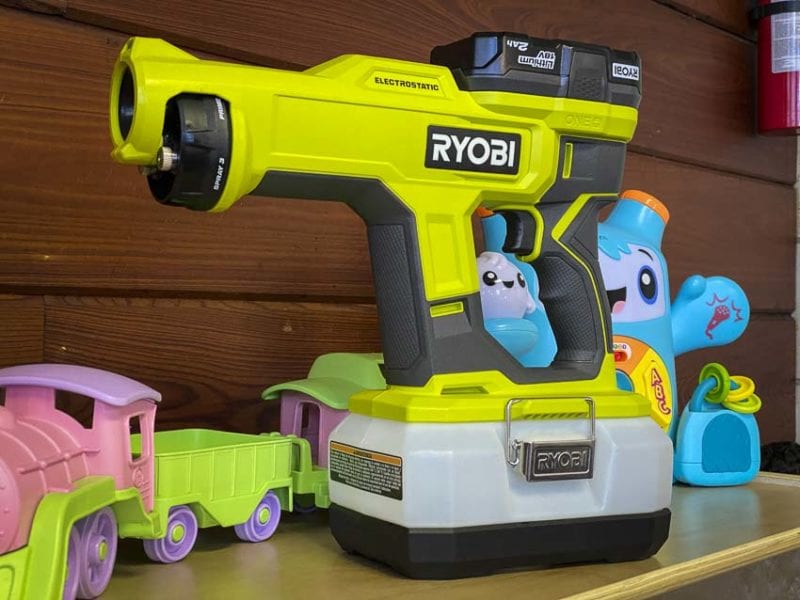
This tool weighs a little over 6-1/2 pounds when filled up. It seems well-suited for quick and convenient spraying of disinfectants, cleaners, and deodorizers. The idea would be to use this when you don’t require large amounts of spray material. The PSP02K features an onboard 1-liter translucent tank that helps keep this electrostatic sprayer light and maneuverable.
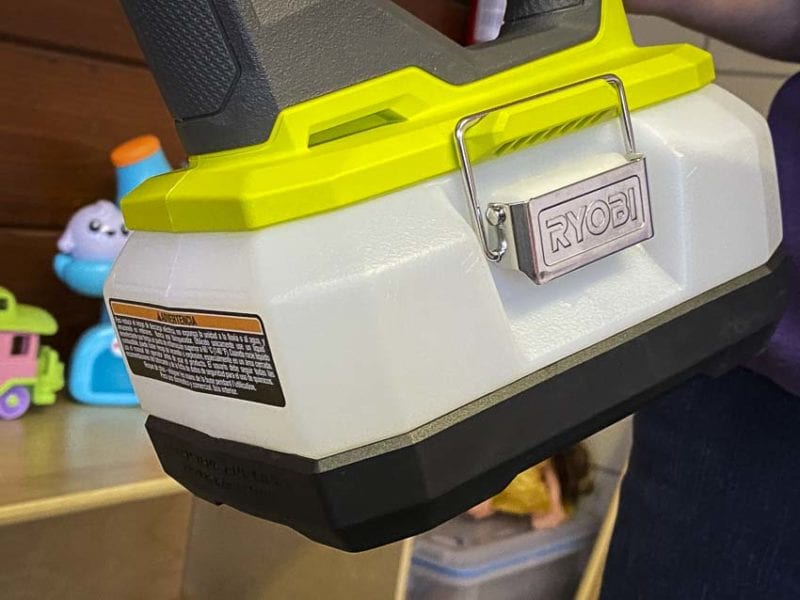
The tank fastens right underneath the tool—where you might typically expect to find the battery. The tool also supports larger tanks if you find yourself on a job where greater capacity helps you out. It attaches and detaches easily with the metal clasps.
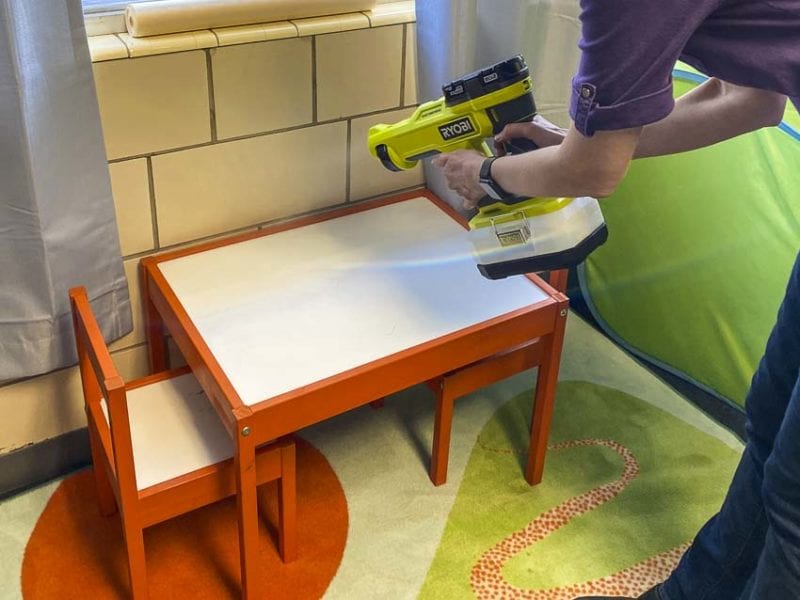
What to Use in an Electrostatic Sprayer
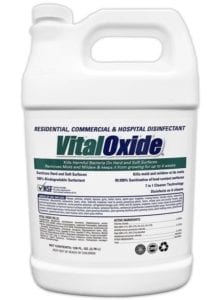
We filled our sprayer with Vital Oxide Disinfectant, which works well for sanitization, mold remediation, and commercial use in kitchen facilities and hospitals. It kills 99.9% of bacteria and sanitizes 99.999% of bacteria on food-contact surfaces with no rinse required.
We wanted something that was food-safe as we were disinfecting toys that would be touched and handled by children. Since this is a nursery, we also know kids like to stick everything in their mouths. Using a safe food-rated product topped our list of requirements!
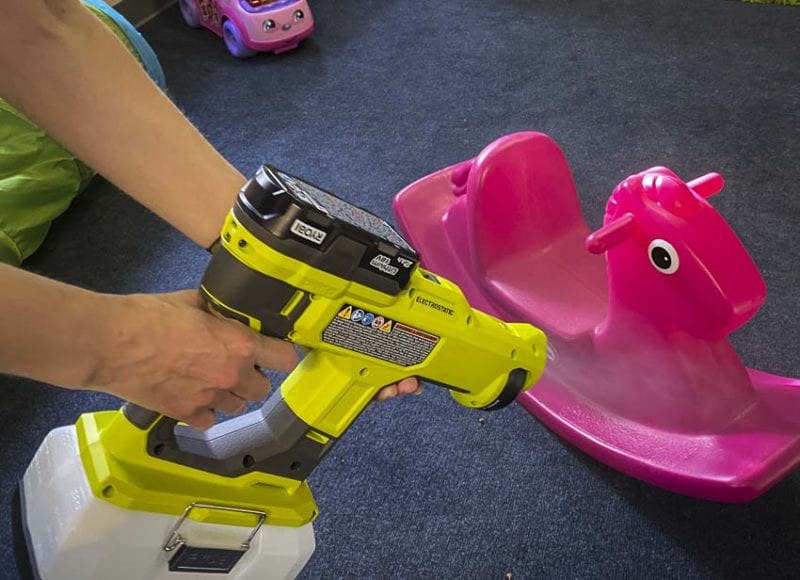
As a neat sidebar, Vital Oxide also eliminates odor at a molecular level as opposed to masking it with a fragrance. For disinfecting, we used it at 100% strength with no dilution. A gallon runs around $38, but you can also get it in bulk at a discount.
Ryobi PSP02K Runtime and Use
To get up and running we just filled the tank with our disinfectant, set the front dial to the “Prime” setting and pulled the trigger. The system spit out some liquid and automatically stopped. At that point, we switched the dial to Spray Mode 1 and began spraying.
With the kitted 2.0Ah battery, the Ryobi PSP02K electrostatic sprayer runs nearly forever. What we mean by that is that you get up to 60 tanks per charge. Doing some quick conversion, that’s almost 16-gallons! We basically recharge the batteries monthly and only because that seems like a good idea.
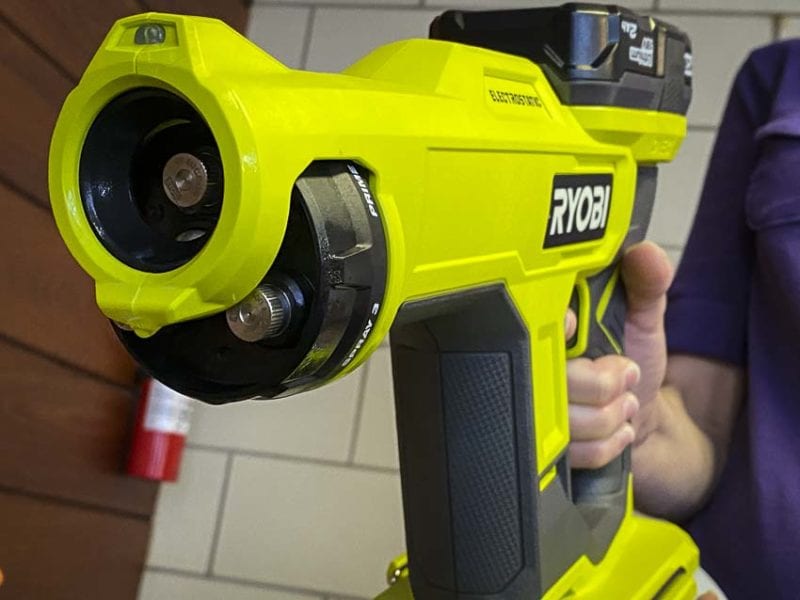
You also have options when it comes to coverage and spray distance. The 3-in-1 adjustable nozzle selector lets you choose between 50-, 75-, and 100-micron size droplets. Ryobi labels this as Spray 1, Spray 2, and Spray 3. We’re used to the Low, Medium, High labels found on their other sprayers, but Ryobi lets users put whatever nozzle size they would like in each space. They sell replacement nozzles as well, so customers can use all the same degree or two 50 and one 100 microns if they prefer.
We mostly stuck with 50-microns. The PSP02K can spray up to 5 feet away so you also don’t need to be on top of the products you plan on disinfecting.
Author’s Note: Just to warn you, this isn’t a “misting” product. It really does spray material. That means that you don’t want to use it on surfaces that you don’t want to get nice and wet. We recommend sticking with non-porous surfaces like plastics and metals where the idea is to apply a nice coat of disinfectant that you can let air dry. Incidentally, Ryobi does make a fogger/mister for insecticide use.
In terms of price, the kit version of this sprayer gives you the best bang for your buck. You get a 2.0Ah battery and a charger for just $30 more than the price of the bare tool.
Ryobi Handheld Electrostatic Sprayer
- Model: Ryobi PSP02K
- Capacity: 1 liter
- Spray Distance: Up to 5 ft.
- Droplet Size: 50-100 microns
- Battery: 2.0Ah (included in kit)
- Runtime: 60 tanks per charge (2.0Ah battery)
- Weight: 4.3 lbs. (empty), 6.6 lbs (full)
- Price: $349 (kit), $319 (tool only)
Ryobi P2870 1-Gallon Backpack Electrostatic Sprayer
For larger, more time-consuming disinfecting, you have the option of the Ryobi P2870 1-gallon backpack electrostatic sprayer. It features a translucent 1-gallon tank that you can throw on your back.
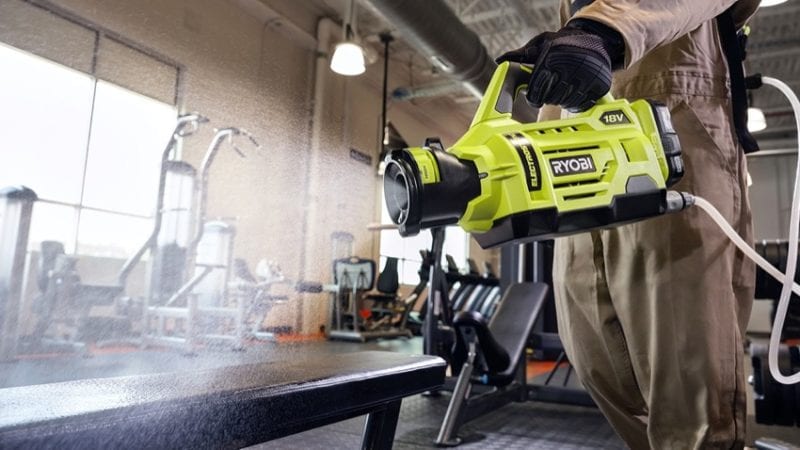
Again, you’ll see the adjustable nozzle selector on the P2870 as well, though this time, you can select between 65-, 85-, and 160-micron droplets. It labels this as Low, Medium, and High. It uses a similar trigger mechanism and can spray material from up to 10 feet away.
We like the dual-ended quick-connects on both the tool and the 1-gallon bottle. You don’t have to waste time unscrewing hoses it when it’s time to refill or put the tool up for the day.
This model runs for up to 30 gallons per charge when using just one of the two kitted 2.0Ah batteries. We didn’t use it long enough to prove that claim. We can, however, say that most people should have near-continuous use by cycling the two included 2.0Ah batteries.
Ryobi 1-Gallon Electrostatic Sprayer
- Model: Ryobi P2870
- Capacity: 1-gallon backpack tank
- Spray Distance: 2-10 ft.
- Droplet Size: 65, 85, or 160 microns
- Battery: 2 x 2.0Ah (included in kit)
- Runtime: Up to 30 gallons per charge (2.0Ah battery)
- Weight: 7.2 lbs
- Price: $429 (kit)
Ryobi P2890 1/2-gallon 18V Electrostatic Sprayer
The last Ryobi electrostatic sprayer we want to mention is the Ryobi P2890 1/2-gallon sprayer. This tool also runs on the brand’s 18V ONE+ battery platform and it gives you some additional capacity in a handheld format.
You activate the electrostatic charging function with a simple on/off switch. A trigger then activates the sprayer. With the kitted 2.0Ah battery, Ryobi tells us the P2890 can spray up to 30 gallons on a charge. That about doubles the capacity of the 1-liter Ryobi PSP02K. It puts this tool in line with the backpack sprayer, but without the tethered hose.
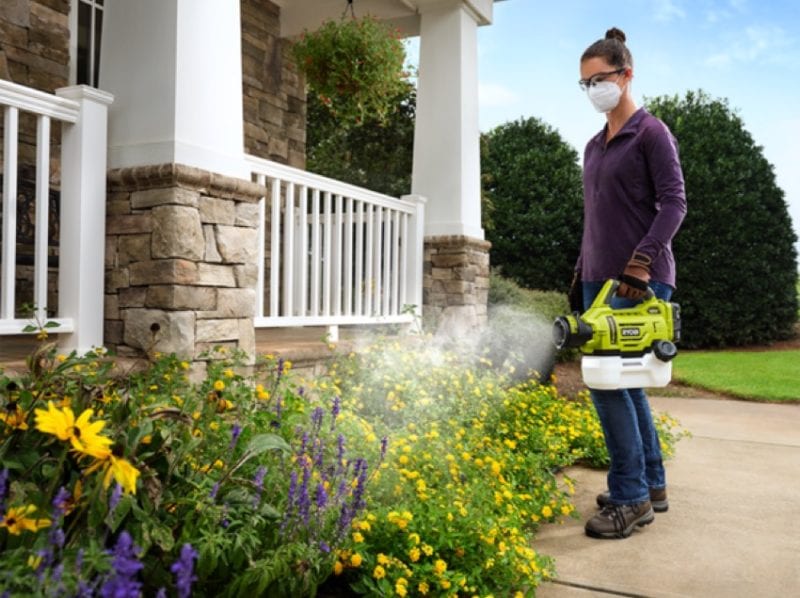
It also features a 3-in-1 adjustable nozzle selector that lets you choose from three different spray patterns. A turn of the nozzle switches between spraying 65-microns droplets up to 2 ft away, 85 microns up to 5 ft away, and 160 microns up to 10 ft away. Ryobi labels these modes as Low, Medium, and High.
With its 1/2-gallon tank, the P2890 should provide the additional capacity you need without the complications of a backpack design. The tradeoff is carrying that weight in your hand. We like the option as it knocks $80 off the price of the P2870 backpack model. You get the option to choose to sacrifice some capacity and one of those 2Ah batteries for a larger, stronger handheld solution.
Ryobi 1/2-gallon Electrostatic Sprayer
- Model: Ryobi P2890
- Capacity: 1/2 gallon
- Spray Distance: Up to 10 ft.
- Droplet Size: 65, 85, or 160 microns
- Runtime: Up to 30 gallons per charge (2.0Ah battery)
- Weight: 7.2 lbs.
- Price: $349
What We Think
Obviously, our use of this included disinfecting large quantities of toys in a church nursery. You could use it for any number of things, like disinfecting a restaurant at the end of the evening, or spraying down an entire school bus between pickup and drop-off.
The fact that Ryobi gives you options for capacity, output, and form factor means they’ve done a great job breaking into this area. Ryobi continues to surprise us with its breadth of products. It’s readily becoming an almost ubiquitous provider of cordless technology for home and business owners alike.
We can highly recommend these sprayers as a great alternative to wiping down surfaces by hand. The electrostatic function just makes it all the more effective. Coupled with the company’s 3-year warranty and the reasonable costs of entry, we highly recommend these electrostatic sprayers for anyone looking to save time when disinfecting and cleaning.

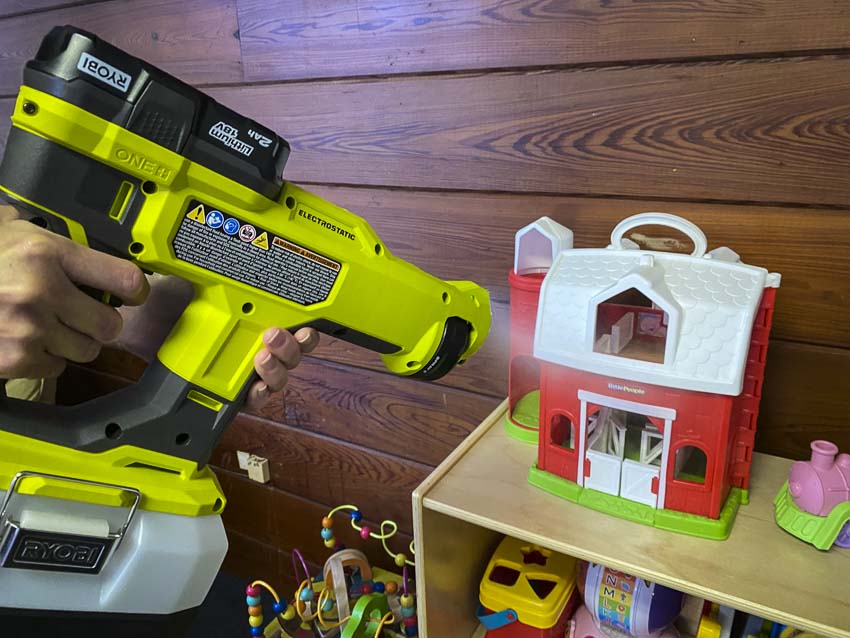
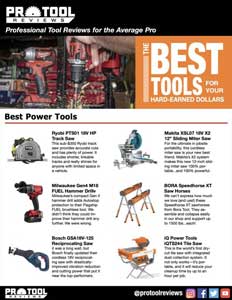

Hi Chris I see that the handheld offers 50 microns is the low setting but the backpack version the lowest setting is 65? is it possible to change the nozzle to get a 50 micron spray on the backpack version?